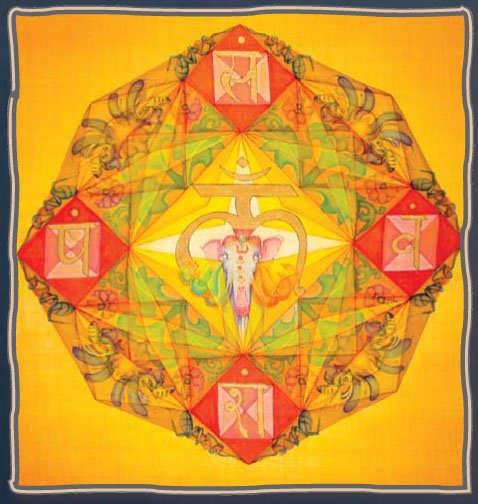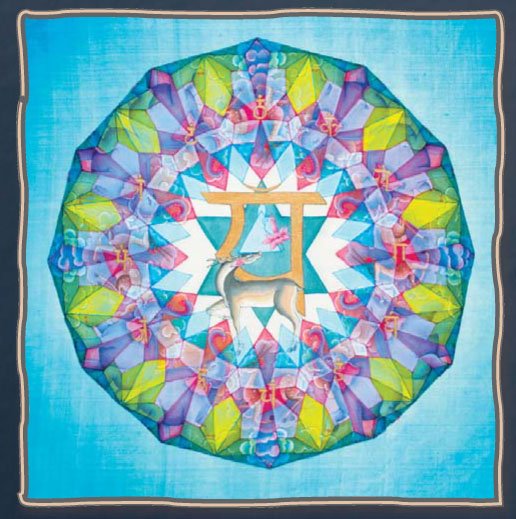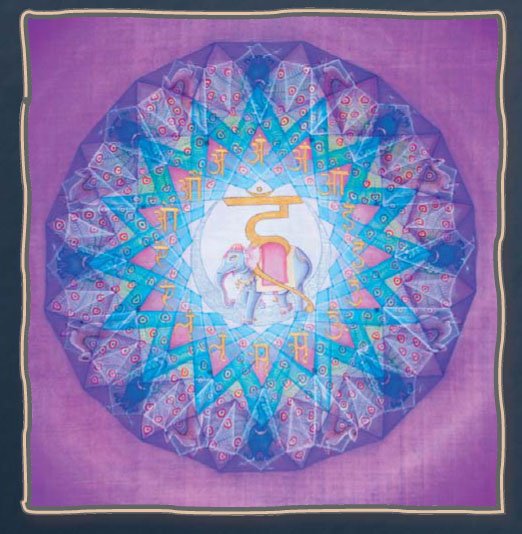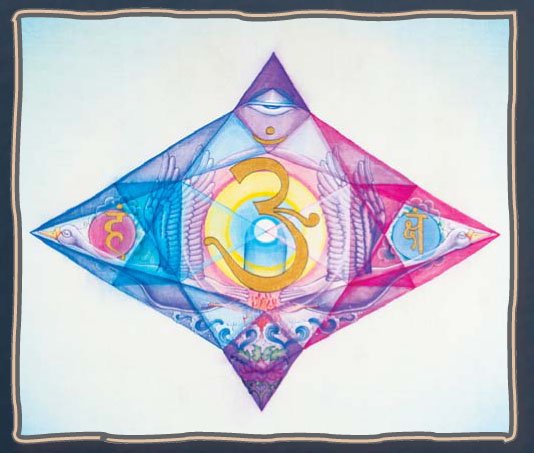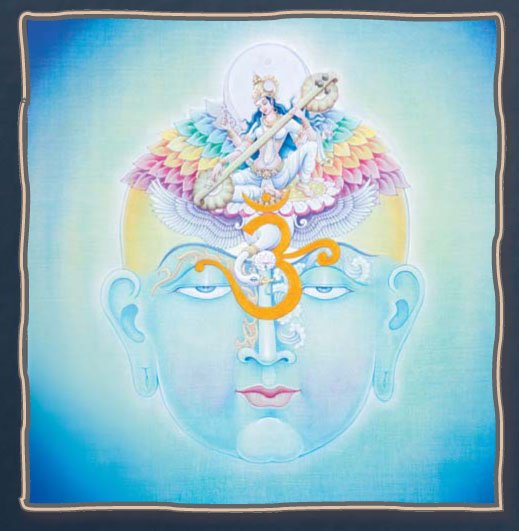The muladhara chakra dominates when we are a child, age 0-6 for girls and 0-7 for boys. For a good journey through the chakras we need to be well grounded. The element of muladhara is earth, which is the foundation on which everything takes place. Earth provides all that we need. It is represented by the square, with its four directions, and by the elephant. The animal nature is like an elephant, heavy, strong and wise. The elephant is also known for its sharp organs of sense (the five jnanendriyas) and action (the five karmendriyas). It is with these powers that we perceive the world and work in it. In this chakra and stage of life, we receive and develop the tools to enter and enjoy God’s creation.
The spiritual beginning of our journey through the chakras is beautifully symbolized by the first Deity we meet, Lord Ganesha, who is honored at the start of any undertaking. If we can see a divine being in this figure with an elephant head and a pot belly, we might be able to see this divine presence everywhere. Our analytical and critical left brain might have problems here. But if we can surrender to the protecting power of Ganesha, faith in our path can emerge. We trust that He will remove the obstacles. The divine in the form of Ganesha is easy to access. He is happy with whatever worship we offer. If we can but fold our hands, and even bend our head downward, the rest will happen by itself.
With His blessings, we can enter the physical world created by Brahma, who rules this chakra. He created the world of the five elements—earth, water, fire, air and akasha—with overwhelming beauty. As a child In the muladhara chakra, we do not yet experience much mind, ego or intellect. We are simply busy learning and surviving, with a focus on food and shelter.
Brahma’s nature is sattvic. That means He is at peace, content in Himself. There is not only beauty in His creation, but also goodness and truth. He carries no weapons and is nonviolent. In one hand He holds the Vedas as a manual for living in His creation. His peaceful nature can be understood when we look at indigenous peoples who reside in the jungle. They only have to take care of food and shelter, while living in harmony with nature by worshiping the spirits in their surroundings. They only take what they need. Our challenge is to find that same balance and discover creation’s peaceful nature in a complex, cosmopolitan world.
The doorkeeper of this chakra is Goddess Dakini, “the Beholder.” Harish Johari wrote that “Dakini carries the light of divine knowledge, which she imparts to yogis.” She shows us how to deal with the ocean of primitive desires connected to our senses. We tend to lose ourselves in the overwhelming, outer allure of nature. Dakini can show us that the real beauty is inside, which expresses itself as happiness. To experience this, we have to live a disciplined life. The five yamas (restraints) listed by Patanjali are good guidelines: nonviolence, truth, honesty, sexual continence and forbearance. These describe the character of our inner self. This is how we all are deep inside. If we can master these virtues, we can enjoy our jungle.
These disciplines help us understand that everything we need is available, but not all that we desire. We have to trust in providence. Then we can live in harmony with nature, and Dakini will show Herself as a Goddess of wealth. If we disobey the laws of nature, She can become the fierce Kali or Tripura Bhairavi, and we will face hard times.
In this chakra there are many addictions. Our food habits are first to be harnessed. Junk food is a weak spot here. We take more than we need. That brings us into a lazy and lethargic mood. At this stage we are usually not aware of the importance of healthy food. Fasting can be helpful; there are many ways, even just abstaining from certain foods.
If we are able, like a baby, to find security in food and shelter, we may enjoy the mental modifications attributed to the four petals of this chakra: the state of great joy, the state of natural pleasures, delight in the control of passions, and the blissfulness of concentration. To have loving and caring parents as first gurus helps us have good experiences here. Then the rest of the journey can be felt as a blessing.
Although spiritual practice in the first chakra is difficult, all the spiritual energies are present in their basic, primitive forms. The downward pointing triangle in the center of this chakra represents Shakti, which we perceive as nature with her seemingly uncontrollable desires. The Lingam is the symbol for Siva, or our immortal Self. He is present right at the beginning, but does not yet have a face. The snake, kundalini shakti, is the energy of our individual consciousness (ego), which longs to become one with our immortal Self. Out of its mouth come the spiritual nerves: ida, pingala and sushumna. If we are grounded in our disciplines, the journey upward can begin.
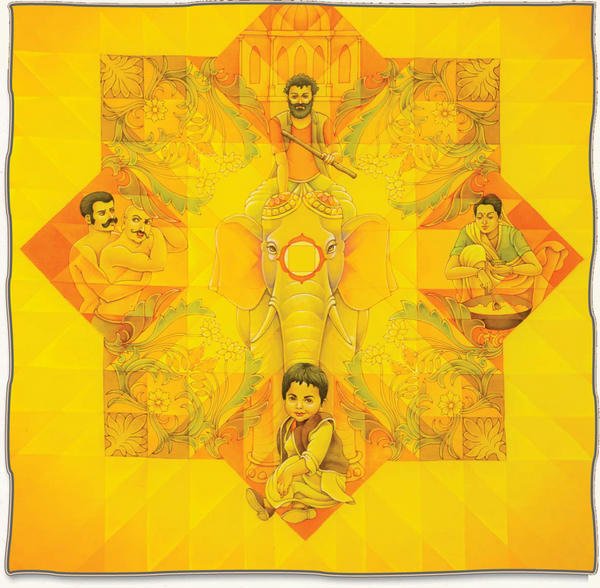
The artist depicts the growth and training of a child, who learns from loving parents. The mother teaches healthful habits of behavior, learning, eating and sleeping. The father helps the boy control his rough and aggressive lower nature by teaching sports, such as wrestling. When strong patterns are set, the child controls his instinctive nature like the mahout controls the powerful elephant.
After our basic needs are secured, we are ready to look around and meet other souls, especially of the opposite sex. The svadhishthana chakra is dominant between age 6 and 12 for girls and 7 to 14 for boys. Its element is water, which can move in all directions and makes life possible. Its connection with the moon brings us into the world of emotional fluctuations. With emotions as spices, our life becomes more flavorful.
The animal nature here is like a crocodile, which is always ready for hunting and loves floating, sunbathing and fantasizing. In this chakra we are confronted with unlimited fantasies. Such fantasies, especially sexual, consume more energy than any other human activity. This chakra creates six mental modifications, bringing us into the world of psychological complications, represented by this chakra’s six lotus petals—affection, suspicion, disdain, delusion, destructiveness and pitilessness. Here we create our own world with the help of our mental and intellectual faculties. This is the world we think and talk about most of the time. It can become so overwhelming that we can lose grip. We need guidelines as we navigate this chakra.
Lord Vishnu appears here, on hand to preserve the creation of Brahma and to maintain harmony and balance. He represents life. He pervades everything. From the smallest to the biggest, life is everywhere. Although science researches life, it is still not able to trace its source in the outside world. As Lord of Maya, Vishnu creates a world in which it is very difficult to find Him. To make it easier, He brings us religion. The goal of every religion is to live in harmony with nature and all the creatures in it. Science can’t say much about religion, but one thing it does confirm is the therapeutic value of faith in easing the impact of suffering, hardship and death.
All religions have two things in common: a theology or philosophy and a moral code. Theology tells us where we come from and where we are going. It deals with karma and with dharma (being one with nature’s laws). In Sanatana Dharma, Hinduism, the moral code is the yamas and niyamas. The five yamas (restraints) help us behave according to the character of our immortal Self, which is defined by the niyamas: purity, contentment, austerity, self-study and respect for worship of God. Our individual spiritual energy is like a locomotive, and our immensely active fantasy world needs a track. That track is religion. But beware, in this chakra spirituality can lose itself in superstitions, omens and dreams. The main job of religion here is to quiet the seemingly uncontrollable tides of this water-dominated chakra.
Rakini, another aspect of kundalini shakti, opens the door to this chakra. Her two heads indicate the duality between “I” and the “other.” The energy of the second-chakra person is spent on attaining a balance between the external world and the world within. The “other” has entered the game, and that can bring mental pollution. Purification is one of the tools Rakini offers. The simplest tool is humming. We often use it unconsciously, such as when confronted with a puzzling situation. It resets the brain. Life itself offers purification through facing hardships, meeting remarkable people, visiting temples, reading scriptures, etc.
During the years dominated by this chakra, good stories are an important way to convey spiritual wisdom and playfully introduce complex philosophical and moral issues. It is important to listen to stories that make sense. Knowledge is not yet internalized. That begins to happen in the fourth chakra. Without religious stories and teachings, life makes little sense. The only thing that remains is making money, which we spend mostly on things and unending entertainment, including social media.
Rakini gives another tool to express our fantasies and keep this mental world under control. Since times unknown, arts and crafts in all their forms have been used to live a harmonious, balanced life, as both hemispheres of the brain, focused on one subject, learn to work together. The right brain is playfully exploring the world by doing. The left brain learns from this as it analyzes the art process to discover symbols and patterns. Playfully we investigate different techniques. It is our first lesson in concentration.
There are unlimited possibilities in the world of entertainment. The arts and crafts make us play, and we become playful. Here we can find a talent to develop for the rest of our life. An art or craft can become a spiritual tool when combined with religion. Our passage through this chakra finds solace in stories of romantic and epic heros like Rama and Krishna, where sacrifice for divine love is more important then sensory satisfaction.
All old cultures had an art and craft world that penetrated the whole society. Everybody was connected in this common dream world (maya) through common spiritual stories, in which Gods and demigods and subtle concepts were introduced. This was and still is the oldest and best therapy. Such stories are intertwined with religious festivals, which inspire people to think about these realities and make creative decorations. In doing so, we feel one as a community, an experience that elevates us all.
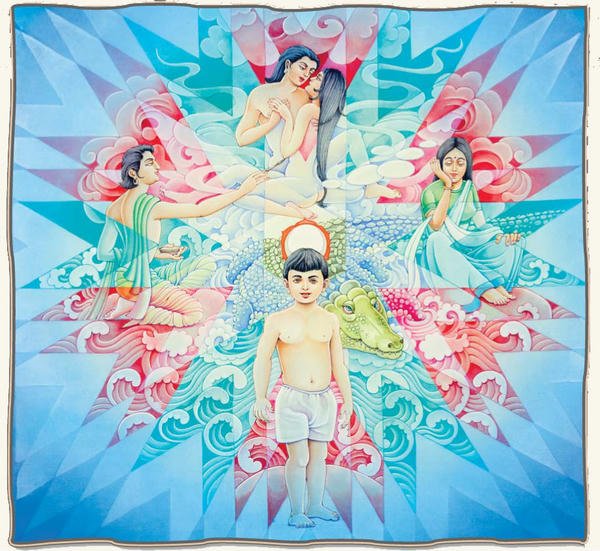
In this chakra youths discover the “other.” This opens the world of desires and fantasies, represented by the crocodile. The creativity of the arts help him or her to attain a balance between the world outside and inside. In this chakra the desire for physical love is born.
In the manipura chakra we enter the world of big games, as we get involved in politics, organizations and other social and economic structures. Name and fame are our primary ambitions during the time this chakra is dominant—age 12-18 for females and 14-21 for males.
The symbol for this chakra is the downward pointing triangle, which represents the energy of fire, which can be purifying, but also destructive. The tendency here is downward, toward exploiting the first two chakras and blocking the energies from flowing upward. Here we find the first knot (Brahma granthi), which ties us to the material and physical world.
Fire is related to the Sun, which is this chakra’s ruling planet. This chakra gives us the intellectual ability to organize, structure and manage. It is at this level of consciousness that society is formed. The need for food and shelter are met, and the aspirations of the second chakra are made practical. Personally, we are able to stabilize our life.
At the same time, our self-created psychodrama becomes more complex and we become more attached. The price we may pay is seen in the mental modifications of this chakra’s ten petals: spiritual ignorance, thirst, jealousy, treachery, shame, fear, disgust, delusion, foolishness and sadness.
The animal nature of this chakra is the ram. While sheep are among the most gentle mammals, the ram, with his famous head-down attack, is a symbol of power and aggression. He is the vehicle of Agni, the God of Fire. In this chakra we feel very special. The ego takes its mature shape here. In the first chakra it was behaving as subordinate, and in the second it was subdued by the other sex. In the manipura, the ego—if left unbridled—is strongly self-centered, ready to selfishly sacrifice everything and everybody, including family and friends. Using this energy, together with like-minded people, we organize ourselves and experience the power to control. While this power can be destructive, without it a society cannot develop. We need this force to organize and structure.
To control this self-centered ego, we face in the third chakra a fierce and mighty Deity: Braddha Rudra, the Weeping One. When we get too attached to our world of name and fame, only the indomitable power of Rudra can stop us. Rudra does not give blessings like the other Deities that rule the chakras. He intervenes forcefully to show us the reality behind worldly life. As Vishnu brings life, Rudra confronts us with death, which can end the kingdom of ego. But death is no end! It is only change. And the ego does not like change.
However, our karmas cannot stay self-centered. This is a misinterpretation of reality. Even when we don’t know about the Truth, the Truth remains the Truth and never changes. So, it is better to understand this Truth. And a long journey upward can commence. Meditation on Rudra helps.
A compassionate, three-headed female Deity, Lakini, shows us the beauty of this chakra. After the physical and mental (astral) planes, the plane of thoughts (celestial) is encountered. Instead of exploiting the world, we see that we can use our new-found power to focus the energy of the first two chakras for the benefit of all. We have the power to create heaven on Earth. Here religions take form, which can make living in harmony with nature more practical. Lakini shows that by organizing a society we can raise the spiritual level of the masses. Saints and saint-like persons like to work within this chakra to inspire humanity.
To have clear and open thoughts we need intense spiritual practice. Then the fire of tapasya can become a great purifier. We need to calm our mind, control our thoughts. And we have to start somewhere. If the body is not free, the mind cannot be free. If the body is quiet, the mind also has a chance to become quiet.
Here asana becomes important, as explained by Rishi Patanjali. We have to find an asana or posture in which we can sit for a long time. For this, discipline is needed. Martial arts and other sports are helpful. With more control over our bodies, the triangle that is fire can start moving up to the higher chakras.
Charity and selfless service are two other important tools to transform our egos into spiritual beings that serve society. When we are focused on the cosmic good, we follow dharma, or truth, and the highest dharma is doing good for others. Only then can we start feeling one with all.
By rightly using the energy of this chakra, we can be inspiring, shining and compassionate personalities who think only of the interests of others. Here we find the saviors of the world, who make the manipura chakra (literally, the City of Gems) shine radiantly. At this stage, the fourth chakra, where Siva reigns as the eternal benefactor, is within reach.

For the young man, awakening of the sensual ego becomes the main problem, as expressed in the fiery nature of the ram. He feels special and wants to be as powerful as a king who owns the city of jewels and entertains himself lavishly. Through selfless service, the king can achieve balance.
In this chakra we start experiencing a state of balance between the male and female energies, as symbolized by the hexagram, which is the merger of two triangles. Doing and thinking are focused on achieving this balance. Here we have our first experience with the Divine, which is anahata, or “unstruck,” “unhurt” or “unbeaten.” We feel happy. This chakra is dominant for females between 18 and 24 and males age 21 to 28. For mothers the anahata opens automatically. The animal nature here is well depicted by the black antelope. It runs around restlessly but always in joy, searching for the source of the smell of the musk that resides in its own navel.
By joining ashrams, monasteries or organizations that serve the cosmic good, we experience the happy state of balance and oneness with all. Meditating with a group helps us reach the level of the group. In ajna chakra we meditate alone to reach higher levels. In the anahatha chakra we experience something we like, but more study is needed. We are restless to find the source of happiness, in search for it everywhere with full enjoyment in our heart.
In the first three chakras, ego is connected to the material world, to security, outer beauty and the world of name and fame. Here, in the fourth chakra, ego opens for a greater cause, and instead of being self-centered it feels one with all. Saints and saint-like people love to abide here. Here we can achieve balance between idealism and materialism, high thinking and creative action.
As with the antelope, we find that this joy is inside us. In the center of anahata we will find an additional chakra, ananda kanda, our spiritual heart. In all conditions, waking and dreaming, our immortal Self is always there, always on duty to serve all. Occasionally we may experience this presence and take selfless action.
Gradually our understanding of our immortal Self gets more defined. As Sadasiva, it appears in the Bana Lingam as the eternal benefactor who has compassion for every creature. From Him we receive the power of language, with which we express our understanding of the causal world. From here comes the inspiration to write. He is the guru inside us who works as our conscience, the inspiring inner voice that accompanies us every step of our life. Warned when we make mistakes, we begin understanding our true character and internalizing the moral code (yamas and niyamas). This brings us into the everlasting happiness behind everything.
Perpetual bliss is the nature of the main Deity of this chakra: Ishana Rudra Siva, the ultimate yogi and source of good. There is balance and harmony inside and outside us. We enjoy pure relationships. We receive, in this chakra, our first spiritual instructions from our guru, ashram or organization. While practicing them we achieve balance and experience happiness. The Shakti that opens the door for us is Kakini.
The lotus petals of this chakra represent 12 mental modifications: hope, anxiety, endeavor, possessiveness, arrogance, incompetence, discrimination, egoism, lustfulness, fraudulence, indecision and repentance. The psychodrama is still going on; but with the help of Kakini we start seeing these modifications as imperfections created by our own attachments.
We yearn to get more grip on this mind. Pranayama and kumbhaka (holding the breath) are helpful to calm the mind. When there is no breath, there is no mind. When the breath is slow, the mind is slow. When we only concentrate on the breath, we can experience a little time without thoughts. When we make that a sadhana, or spiritual practice, we can prolong our concentration and experience meditation.
Then instead of holding a wrong identification with the world of maya, Kakini can show us the divine play (leela) in this seemingly chaotic illusion (maya) that is created by Vishnu. Also He is hiding in our spiritual heart in the form of Narayan, or the human incarnation. To find Him our life has to become worship while performing our duties in family and society. Then it becomes leela, the divine play.
Religion now becomes internalized. Following a spiritual path seems needed to discover the depth of the divine game. Surrendering to a guru who has followed that path is helpful to have confidence in the path and to remove the ignorance that makes maya look so real. To accomplish this we need bhakti or spiritual devotion, the essence of this chakra. To experience this devotion Kakini brings us devotional and spiritual forms of arts and crafts and their enjoyment. The worldly arts of the second chakra are transformed to devotional and inspired art of the fourth.
The last Goddess, Kundalini Shakti, represents this devotion or bhakti. Now She sits in a upward-pointing triangle. In the first chakra She was a dangerous snake. Here She becomes a Goddess. She represents the devotional side of our ego, which longs for union with Her Lord, or our immortal Self. It is like Radha with Her divine love for Krishna. We are no longer a victim of desires connected to the material world when we are able to surrender our ego. Then we are able to experience divine love (prema) everywhere, in everything and for everybody.
To continue our path, Kundalini Shakti gives us important tools. As Goddess of speech and sound, representing anahata nada or cosmic sound, She provides us with the 50 matrikas and all the mantras. In group settings we learn to play with them. Bhajans can help us experience a peaceful and happy world without thoughts. No more value judgments, but instead an open mind. We are ready to enter the fifth chakra to learn more about these sounds.

The spiritual heart of the adolescent opens, which is expressed by the deer. He becomes firm in his asana. The eyes indicate his awareness of the divine in all existence. Following a spiritual path makes life fulfilling and worthwhile. For a mother this chakra opens automatically.
We enter now the world of akasha, space or void, the purest element, in which the other four elements appear. Akasha arises from nada, pure cosmic sound, symbolized by the crescent moon. Represented by the circle, akasha has many forms—from the space between atoms to the void in a vessel, and from the subtle space created by mantra-repetition to the supreme cosmic void, where there is nothing but space. At this level we come in contact with pure knowledge, which we need to untie the Vishnu-granthi, the knot that binds us to the diversity inside the unity. In this chakra we discover the unity in the diversity. Vishuddha dominates between the age of 24 and 30 for women and 28 and 35 for men.
In the anahata chakra we discovered the beauty, goodness and truth outside us. Now, in the fifth chakra, we come to know that the Divine is inside us, that we are divine; as outside, so inside. When no longer distracted by outside noise, we hear our own inner sounds: heartbeat, breathing, fluids and gasses. The awakened will hear music, mantras and the powerful nada-nadi shakti, which sounds like a thousand vinas playing in the distance, or a swarm of honey bees nearby.
The seers of the ancient world distinguished the basic sounds to create the matrikas, the 50 letters of the Sanskrit alphabet. One matrika is connected to each of the 50 lotus petals in the first six chakras. Working with these sounds is one of the best ways to balance the chakras. Start with the first chakra and move upward, one chakra at a time, ending in Aum at the ajna. This meditation makes one feel grounded and prepared for meditation on the third eye. Here we become aware that all knowledge is inside us.
The animal nature of the elephant, which prevails in this chakra, also points to knowledge. After this chakra, there are no more animal desires. The power of the elephant, the symbol of knowledge here, is needed to deal with the world of the senses. From the elephant we can learn to be patient, to have self-confidence, to remember what we have learned and to enjoy our oneness with nature. With this wisdom we can survive in the material world. But to go higher we need a teacher. The Deity of this chakra is Panchavaktra Siva. In this five-faced Lord we find the guru, who helps us realize our true nature. Our spiritual darkness ends in this chakra, which is the source of all great religious teachings. At this stage Siva reveals His grace and shows us that we were never separated from Him.
This is the chakra of spiritual teachers. Even they still have challenges, attachment to the desire to communicate with others, attachment to this still-worldly position. And there is even the danger to misuse their knowledge or stop practicing the teachings themselves. In the austere attire of Siva we can glean the most important axiom for this chakra: simple living and high thinking. With no distractions from the world of luxury, we are more able to make unattached refections.
Shakini, who closely resembles Sarasvati, is the doorkeeper to the vishuddha chakra. She represents the knowledge behind education and the fine arts, two important tools in this chakra, not only school education, but also cultural education, learning to be a good father or mother, brother or sister, friend and neighbor. The highest art is the art of living.
Fine arts and crafts are part of and support cultural education. To master them we need to improve our concentration. In the arts and crafts we learn in a playful way to withdraw from the senses. While creating, we forget everything and are focused on one subject. At that moment there is no ego, and art can become inspired. Then we can play with dreams in a way that words cannot. Or we use poetry. Most religious texts are written in poetic style or dream-like stories with profound hidden messages. Shakini introduces us to the world of silence that no words can describe, and reveals the importance of non-verbal messages, like body language and facial expressions.
Knowledge is not yet fully realized in this chakra. We have become aware of its existence, but we are still in the world of desires and the karmas that they create. When we discover knowledge, ignorance appears also. It is not in nature, but it is in us, in our mind or our thoughts. A lot of education is needed, and Shakini is there to give it.
In the fifth chakra we become aware that to control the senses, we have to control our mind. Patanjali calls this pratyahara, withdrawal of the senses. We all know how difficult this is. Seeking control, we practice withdrawal of the senses in meditation. We also practice it in the fine arts and the karma yoga of daily life. When we are deeply engaged with music, painting, sculpting, animation, gardening, cooking, planning and organizing, there is nothing else. Whenever we are absorbed in something, withdrawal of the senses is happening. We learn that deep concentration with complete absorption is within our grasp.
We can work even more directly on controlling the mind by using breath suspension (kumbhaka). Here the ultimate aim is to withdraw the mind in the Self. Another practice to keep focused on the Self is japa, or mantra-repetition. After many years of deep study, we are ready for some real practice in the ajna chakra.
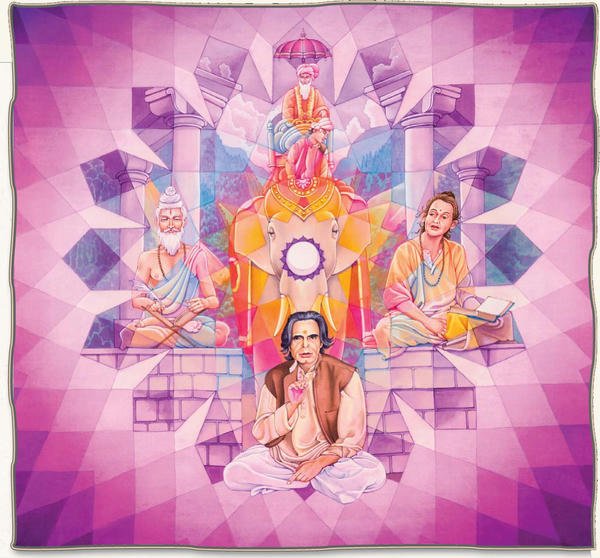
Thirsting for true knowledge, the seeker enters the world of the teachers. Scriptures are studied at this stage, the sacred texts that contain all past knowledge, represented by the elephant. Here spiritual poetry and philosophy are composed. In this artwork, Pieter has painted three figures from his own life: Harish Johari, his guru, in the center; Narmada Puri, a German sadhu and teacher, on the right; and on the left Santoshpuri, a legendary master.
In the ajna chakra we reach a place where the male and female energies within us are becoming one. The ida and pingala spiritual nerves end here [though some teach they continue into the crown chakra], and sushumna—the path to cosmic consciousness—opens. The distractions of the lower chakras lose their power. Only by hard work (tapas) do we experience this level of mind. And for that we have to be able to be alone without feeling lonely. Just as the yogi withdraws inside his cave, we must find the cave inside ourself. Once we have discovered it, we can find shelter and peace no matter where we are, and melt into our immortal Self, the ever-present witness to our personal psychodrama.
Life is now like watching a movie while experiencing the ineffable Divine. We have arrived at a place of inner neutrality, devoid of value judgments. The primal sound of the universe, Aum, is our constant companion. This chakra is dominant between age 30 to 36 for women and 35 to 42 for men.
The Deity here is Ardhanarishwara. In this form the Almighty shows us that Siva and Shakti are one. They cannot exist without each other. They are like our split brain. We have a male side that is electric and gives shocks. And we have a female side that is magnetic and attracts.
The male side is dominant in the first chakra (surviving), in the third (organizing), and fifth (intellectualizing). In the second chakra (outer beauty), and the fourth (inner beauty), the female side is more active. With the presence of Hakini, the Shakti of ajna, we see an emphasis on the female again. Siva is the Sun and Shakti is the Moon. Her moon-influenced energy, our feminine side, allows for meditation to be possible, for She has no thoughts, no value judgments, no time consciousness.
Hakini has six heads. The attributes of the first four are especially developed here: undivided attention, perfect concentration, thought control and enlightenment. These powers are needed to untie the final knot: Rudra Granthi. First we had to untie the knot that binds us to the world of names and forms, maya. Then we had to untie the knot of attachment to the fruits of our actions, karma. Now it is time to unravel the knot of anava, I-consciousness, or ego: the illusion that we are separate.
These four qualities are also needed for another gift from the feminine side: arts and crafts and their enjoyment. Inspired by Hakini, these efforts become spiritual. Now we can work enjoyably for long periods without disturbance or discomfort, in a state without ego, and we can even experience enlightenment. We reside in blissful, neutral happiness when thinking and doing are focused on one spiritual subject. This is not yet unitive meditation, in which the distinction between meditator and the object of meditation does not exist.
Before we can really meditate, we have to work hard on our concentration. Commonly when we talk about meditation, we actually mean concentration. Concentration can be honed while engaged in the arts and crafts, or by focusing on a mantra, yantra, Deity, flame or even a point. Meditation on a particular aspect of the Divine can help us improve our concentration.
Once we are one-pointed, intuitive solutions will appear. It is not yet unobstructed meditation and superconscious concentration (samprajnata samadhi), which are the fifth and sixth heads of Hakini. Thoughts are still there. But we have experienced that thinking and doing can be focused on one subject, and that can develop into meditation, where thinking and doing reach their most subtle form. When we see a yogi doing something, he is actually doing nothing. When we see him doing nothing, he is working very hard.
In the fourth chakra we became aware of our conscience. With the help of the guru of the fifth chakra, we can now meet the guru within. We may have freed ourselves from political and social games, but we cannot—and would not want to—escape our inner voice, our guide to enlightenment.
In the ajna chakra, all that humanity has learned through experience is present in the form of the collective unconscious. This akashic library opens now for us.
A most useful tool at this stage is japa. We may have played with it before. But now it has to become serious. Counting the repetitions is needed to establish japa as an potent sadhana. After years of practice, japa may become more mature and automatic, with counting no longer required. Japa frees us from worries and other distractions, opening us to the innate, peaceful silence within. Siva as Itara Lingam symbolizes this state in which lower-chakra desires are subdued because the subtle mind (sukshma manas) is under control and the masculine-feminine energies are in balance.
Working hard in this chakra, we begin to see new perspectives for our life on Mother Earth. We understand that all the suffering we experienced in the lower chakras was needed to bring us to where we are now. We don’t blame others anymore. Without valuations, we open ourselves for the divine game we are playing on this Earth. And we become curious about what more we can experience here. To fulfill our dharma, we still have to perform actions (karma), but we don’t want to create new negative karma. We do our duty to the best of our ability, in full contentment, while maintaining our disciplines, our tapasya.
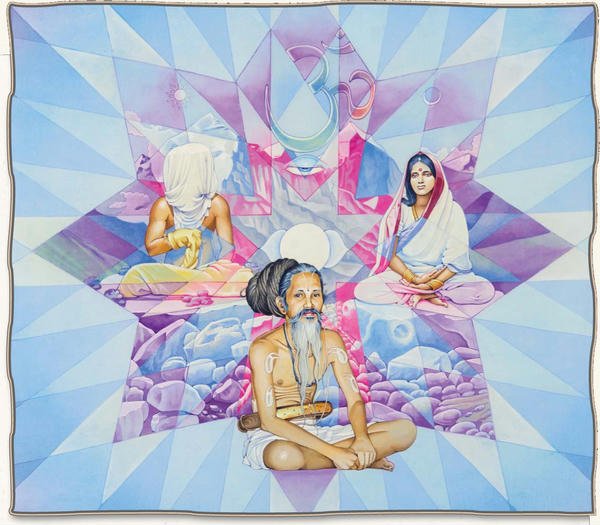
Here the mature seeker becomes a yogi, no longer bound by time. All duality stops here. He has discovered the Divine in himself after long meditations and arduous sadhanas. He has become true (sat). From this chakra, sacred scriptures are written. In the forefront sits Avadh Behari Das Kathiababa, a dear friend of the artist. At the right is the renowned Bengali saint Anandamayi Ma (1896-1982). The person on the left wishes to remain unknown.
As we enter the seventh chakra, we encounter two minor chakras located within the sahasrara. The first is soma chakra, or “moon center,” of female energy, revered as the source of all desires. Having opened ourselves to the moon-influenced feminine energy in the sixth chakra, we now reach the realm of Kamadhenu, the wish-fulfilling cow. At this level of consciousness, whatever the adept wishes for comes true. Because ego is dissolved, his wishes concern the good of all. Only real yogis can gain and make use of this power.
Kameshwara is the other minor chakra within sahasrara. Here Shakti as Kameshwari, the Goddess of desire, unites with Siva as Kameshwara, the Lord of the desire principle. The one who desires is now one with the One who fulfills desire. Here, in the ultimate non-experience, individual consciousness dissolves in the immortal Self. This is called Self Realization.
The higher we ascend, the more subtle the inner realms become, and words can fail us here. To reach the crown chakra requires laboring hard to bring our individual consciousness back to its source. In this chakra we can experience this source. Here we can enjoy uninterrupted meditation, where mind, ego and intellect are dissolved. Classically, this is known as turiya, the transcendent “fourth” state. It is like a deep sleep, but we are neither conscious nor unconscious. Here the adept is free from all attachments. The mind is finally still. The period of life at which people would ideally unfold into this chakra is between the age of 36 to 42 for women, and 42 to 49 for men.
Up to the sixth chakra, we are naturally limited to meditation with form (saguna). The left hemisphere of our brain produces the concept and the right gives the percept. Through this process we learn about the different aspects of consciousness. In the seventh chakra, meditation without form (nirguna) becomes possible, focusing on Truth, which has no form, no shape and never changes.
In the first seven steps of Patanjali’s eight-fold (ashthanga) yoga, success depends primarily on the effort and diligence of the seeker. In the last step, samadhi, fulfillment depends on the grace of God, Gods and guru. Such grace comes when least expected. The rare few, having evolved in the inner arts for lifetimes, are granted the experience of Self Realization. Yet this is the destiny of all souls, without exception. As individual consciousness and the supreme consciousness become one, we enter the rarefied world of Siva, who shows us the reality behind creation. Now we can truly say, “Sivoham, I am Siva, the immortal self, the witnessing consciousness.”
Even after Self Realization, we are still not out of the game. We still need action (karma) to fulfill our dharma. Although ego was subdued in the sixth chakra, even here it can still persist and become big and powerful, even making the yogi a danger to society. With his focus no longer upward, only downward remains, and soon he must start all over again, but with the advantage that he knows the destination to be reached. The wise aspirant keeps the ego in check, guarding his humility as a sacred treasure, knowing that there remains much work to be done. He must become one with cosmic consciousness, with the living concept that penetrates everything, from the smallest sub-atomic particle to the largest star. Coming out of samadhi, a mature and accomplished yogi strives to abide in a state of effortless oneness, sahaja samadhi, seeing everything as forms or sparks of the Divine.
There is still one more step we have to take after Self-Realization. We have to become one with cosmic consciousness, with the living concept that penetrates everywhere, from the smallest atomic particle to the largest star. In the tradition of my guru, Harish Johari, that concept is represented by Vishnu, the Lord of Maya and Master of the game (Leela). When we become Siva, we have to ask ourselves what is Siva doing. He is constantly in meditation and His favorite mantra is Ram. He loves to watch the game of Vishnu and even joins as Hanuman. His motto is: don’t think, just enjoy! Now we can realize this. Siva and Vishnu, like life and death, cannot do without each other. This is best expressed in the form of Harihara, half Vishnu and half Siva. They worship each other. As immortal selves (Siva), we now worship the life that is present everywhere (Vishnu); and in life’s highest achievement, we surrender to our immortal self.
Living on Earth, the best way of becoming one with Vishnu is by serving Him. For that we must simply do our duty. Siva as Hanuman is the supreme example.
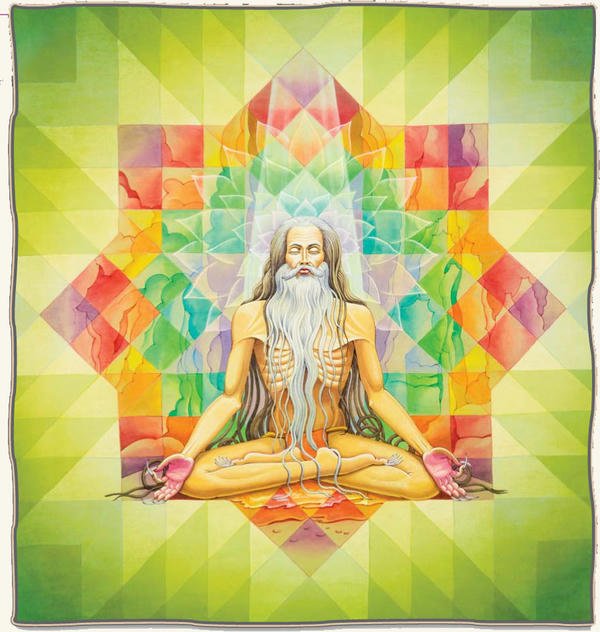
Entering the sahasrara chakra, the adept yogi becomes his real Self, which is the Self in all. He has concluded the spiritual journey and transmuted his humanness into pure divinity, which we can feel in his presence, a divinity that, while yet to be known, is also inside us all.



